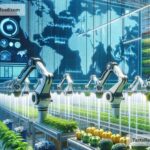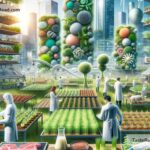The Future of Food and Globalization: What’s Next?
Food is one of the most important parts of our lives. It doesn’t just keep us alive; it also connects us to our culture, family traditions, and the world around us. But as the world changes quickly, food is changing too. Globalization—a process that connects countries through trade, travel, and technology—is reshaping how we grow, share, and eat food on a global scale.
So, what does the future of food look like in this fast-changing world? Let’s explore some of the big trends and ideas shaping what we’ll eat and how we’ll get it.
Globalization and Food: A Growing Connection
Globalization has made the world feel smaller. You can walk into almost any grocery store and find bananas from Ecuador, rice from Thailand, or coffee from Colombia. Restaurants serve sushi, tacos, and pasta under one roof, and many of us watch cooking shows from countries we’ve never visited. This deep connection between countries has brought more variety to our plates than ever before.
On one hand, globalization has made food more accessible and exciting. It connects farmers in one part of the world with consumers thousands of miles away. For instance, someone in Canada can enjoy avocados shipped from Mexico, while someone in Japan can sip wine made in California. This creates opportunities for farmers, businesses, and consumers to share and enjoy foods that were once hard to get outside their native regions.
On the other hand, globalization also comes with challenges. The process of shipping food across the globe leaves a large carbon footprint, contributing to environmental problems like climate change. Over-reliance on global supply chains can also make food systems vulnerable. For example, when COVID-19 disrupted international shipping, some countries faced shortages of imported goods. Balancing the benefits and risks of globalization will be key as we look to the future of food.
The Rising Demand for Sustainable Food
As the global population grows, feeding billions of people becomes a big challenge. Experts predict we’ll have nearly 10 billion people on Earth by 2050, which means we’ll need more food than ever before. But growing food the way we do now—using lots of water, chemicals, and land—isn’t sustainable. It’s already harming the planet.
In the future, we’ll need to focus on sustainable practices to grow food while protecting the Earth. Here are some ideas gaining attention:
-
Plant-Based Foods: Many people are shifting to eating less meat and choosing plant-based options like tofu and veggie burgers. Producing plants takes less water and energy than raising animals for meat, which helps reduce the impact on the environment.
-
Vertical Farming: Instead of growing crops in fields, vertical farming uses tall indoor structures to grow food. It saves space, uses less water, and can grow food in cities where farmland isn’t available.
-
Reducing Food Waste: Millions of tons of food are thrown away every year, even though people in many parts of the world don’t have enough to eat. Future technologies and global efforts will aim to reduce waste and make sure food gets to those who need it most.
Tech Innovations in Food Production
Technology has already changed how we grow, prepare, and distribute food, and it will play an even bigger role in the future. Here are some exciting developments:
-
Lab-Grown Meat: Scientists are creating meat in laboratories without raising animals. This could help solve ethical concerns and reduce the environmental impact of traditional meat farming.
-
Precision Farming: Farmers are using drones, sensors, and artificial intelligence (AI) to monitor crops and make better decisions about watering, fertilizing, and harvesting. These tools help farmers grow food more efficiently and with less waste.
-
Alternative Proteins: Foods like insect-based protein and algae might become important sources of nutrition in the future. They’re cheap to produce, packed with nutrients, and environmentally friendly.
The Role of Global Collaboration
Globalization has taught us that we’re all connected. Food plays a big part in this connection, from the flavors we share to the challenges we face together. As food systems become more globalized, countries will need to work together to address problems like hunger, food security, and climate change.
One promising example of global cooperation is the sharing of agricultural knowledge. Scientists and farmers across the world are developing drought-resistant crops, better fertilizers, and techniques to grow food in challenging climates. Sharing these innovations can help ensure food is available for everyone, especially as weather patterns become more unpredictable due to climate change.
The Future of Food Culture
Globalization isn’t just changing how food is grown—it’s also changing how food brings people together. As cultures mix, new food traditions are being born. Fusion dishes, such as Korean tacos or sushi burritos, show how different cuisines can come together to create something fresh and exciting.
At the same time, people are becoming more interested in the origins of their food. Local food movements are growing as consumers seek healthier, fresher options and want to support nearby farmers. This balance between global variety and local appreciation will be an ongoing trend.
Looking Ahead
The future of food is filled with possibilities. Technology, sustainability, and global collaboration will play key roles in shaping how we grow and eat food in the coming decades. While globalization has brought challenges, it has also created a unique opportunity to learn from and help each other on a global scale.
As we look ahead, the choices we make about food—what to eat, how to grow it, and how to share it—will define how we care for our planet and each other. One thing is certain: food will continue to be a powerful connection between people, cultures, and the future we’re building together.
What do you think the future of food holds? Share your ideas in the comments below!


